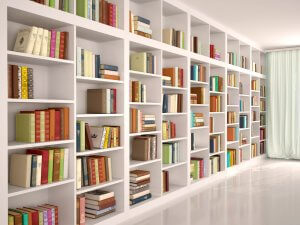Practical Tips for an Organized Library

A neatly organized library is a haven for any avid reader. However, many of the most common organization methods won’t actually be that effective in achieving your desired look. In fact, some might even have the opposite effect.
What a reader wants more than anything is functionality and efficiency. Having a well-organized library allows you to see every title at a glance, saving you time when searching for a particular book. In other words, a practical arrangement helps reduce any difficulties you might otherwise face when starting (or re-reading) a book.
Functionality can be broken down into the following: order, ease of access, and simplicity. Of course, we can’t forget about the more aesthetic aspects, such as harmony, originality, and style.
Initial aspects to take into account
There are several things you’ll need to consider before you start thinking about or reorganizing your library. Firstly: what’s actually in your library? Just books? Or are there also magazines, fanzines, comics, or other items of reading material? And what about other ornaments and decorations on the shelves?
If your library contains other items as well as books, it’s important to work out how all these elements interact with the space. How well do they work with the rest of the decor? Does their arrangement allow you to make the most of your shelf space? Or would it be better to take them down and rearrange them somehow?

Furthermore, it’s important to remember that we often accumulate books that we no longer need or read. These generally include academic texts, guides, and various papers. These only take up space and make shelves look messy and disorganized.
In some cases, you can donate any up-to-date books or papers that are still in good condition, giving them to public libraries or educational institutions. This will help free up space in your home and is a great way to make a positive contribution to cultural and social well-being.
As for any books that have been damaged by humidity, insects or just general wear-and-tear, you’ll need to take certain measures before you can donate them. For example, you could take your books to a book restorer, or simply separate them from the rest of your collection to prevent other books from deteriorating.
Steps for creating an organized library
First, take down all the books, emptying the shelves completely. Next, clean every shelf, then do the same with the books. Now that you have a full view of all the available space, it’ll be much easier to order your books properly.
Second, think about how to organize your books: by color, size, thickness, publisher, author, genre, etc. If you decide to organize them by physical appearance, you’ll need to decide whether you only want to see the spines, or whether you want to arrange one to display a favorite cover or design.
It’s generally best to avoid stacking your books one on top of the other in piles, as it’s all too easy for books to become disorganized. It can also be visually overwhelming, making it more difficult to see the different titles, especially those at the bottom.
Third, you have to try to limit the space. Often, the less space you have available, the easier it is to organize the books. However, it’s important not to go overboard.

So, how can you limit the amount of shelf-space in your library? Quite easily in fact. All you need to do is place an ornament or other accessories on the shelf to take up some of the space. It can also serve as a sort of bookend to keep your books upright. This accessory could be anything, from a clock or photo frame to a potted plant.
If you like to borrow books from your local library, setting aside a small space for them will help keep your library organized. We recommend using one of the lower shelves to make it easier to access your borrowed books.
The KonMari method for an organized library
The famous methods of Japanese author Marie Kondo include a special section on organizing books. In short, she suggests taking the time to carefully evaluate which books you really want to keep, so that you can arrange them more easily.
So, why not give it a go? Put all these ideas into practice, and find out which option works best for your space and your style. You’ll be surprised at just how much having an organized library can improve your environment and your mood.
A neatly organized library is a haven for any avid reader. However, many of the most common organization methods won’t actually be that effective in achieving your desired look. In fact, some might even have the opposite effect.
What a reader wants more than anything is functionality and efficiency. Having a well-organized library allows you to see every title at a glance, saving you time when searching for a particular book. In other words, a practical arrangement helps reduce any difficulties you might otherwise face when starting (or re-reading) a book.
Functionality can be broken down into the following: order, ease of access, and simplicity. Of course, we can’t forget about the more aesthetic aspects, such as harmony, originality, and style.
Initial aspects to take into account
There are several things you’ll need to consider before you start thinking about or reorganizing your library. Firstly: what’s actually in your library? Just books? Or are there also magazines, fanzines, comics, or other items of reading material? And what about other ornaments and decorations on the shelves?
If your library contains other items as well as books, it’s important to work out how all these elements interact with the space. How well do they work with the rest of the decor? Does their arrangement allow you to make the most of your shelf space? Or would it be better to take them down and rearrange them somehow?

Furthermore, it’s important to remember that we often accumulate books that we no longer need or read. These generally include academic texts, guides, and various papers. These only take up space and make shelves look messy and disorganized.
In some cases, you can donate any up-to-date books or papers that are still in good condition, giving them to public libraries or educational institutions. This will help free up space in your home and is a great way to make a positive contribution to cultural and social well-being.
As for any books that have been damaged by humidity, insects or just general wear-and-tear, you’ll need to take certain measures before you can donate them. For example, you could take your books to a book restorer, or simply separate them from the rest of your collection to prevent other books from deteriorating.
Steps for creating an organized library
First, take down all the books, emptying the shelves completely. Next, clean every shelf, then do the same with the books. Now that you have a full view of all the available space, it’ll be much easier to order your books properly.
Second, think about how to organize your books: by color, size, thickness, publisher, author, genre, etc. If you decide to organize them by physical appearance, you’ll need to decide whether you only want to see the spines, or whether you want to arrange one to display a favorite cover or design.
It’s generally best to avoid stacking your books one on top of the other in piles, as it’s all too easy for books to become disorganized. It can also be visually overwhelming, making it more difficult to see the different titles, especially those at the bottom.
Third, you have to try to limit the space. Often, the less space you have available, the easier it is to organize the books. However, it’s important not to go overboard.

So, how can you limit the amount of shelf-space in your library? Quite easily in fact. All you need to do is place an ornament or other accessories on the shelf to take up some of the space. It can also serve as a sort of bookend to keep your books upright. This accessory could be anything, from a clock or photo frame to a potted plant.
If you like to borrow books from your local library, setting aside a small space for them will help keep your library organized. We recommend using one of the lower shelves to make it easier to access your borrowed books.
The KonMari method for an organized library
The famous methods of Japanese author Marie Kondo include a special section on organizing books. In short, she suggests taking the time to carefully evaluate which books you really want to keep, so that you can arrange them more easily.
So, why not give it a go? Put all these ideas into practice, and find out which option works best for your space and your style. You’ll be surprised at just how much having an organized library can improve your environment and your mood.







